Luxembourg 1984 "Fossils"
| <prev | back to index | next> |
| Issue Date | 10.09.1984 |
| ID | Michel: 1107-1110; Scott: 714-717; Stanley Gibbons: 1138-1141; Yvert et Tellier: 1057-1060; Category: pF |
| Design | |
| Stamps in set | 4 |
| Value |
4 F. - Pecten (mollusk shell) 7 F. - Gryphaea arcuata 10 F. - Coeloceras raquinianum 16 F. - Dapedium |
| Emission/Type | commemorative |
| Issue place | Luxembourg |
| Size (width x height) | 28.30mm x 33.70mm |
| Layout | |
| Products | FDC x1, MC x4 |
| Paper | |
| Perforation | 11.5 x 11.5 |
| Print Technique | Photogravure |
| Printed by | Courvoisier (Helio Courvoisier) S. A. |
| Quantity | 500.000 |
| Issuing Authority | Post of Luxembourg |
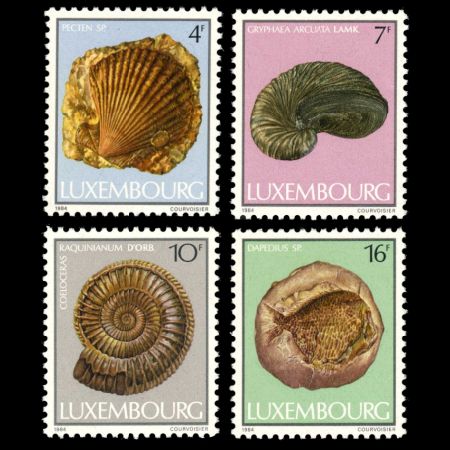
On September 10th, 1984, the Post of Luxembourg issued the set of four stamps "Fossils in the Natural History Museum". These stamps show fossils found in Luxembourg and are part of the paleontological collection of the Natural History Museum in Luxembourg.
All four fossils belong to the animals who lived during Jurassic Period of the Mesozoic Era.
"Luxembourg" at that time looked much different than it does today. During the Early Jurassic, the giant continent of Pangaea started to break apart. The land area of Central and Western Europe consisted of many small islands, surrounded by shelf seas (with a maximum depth of 200 meters), which are therefore flooded with light, warmth and rich in species. The majority of "Luxembourg" lay under such a sea, a small part in the north was part of a land mass that stretched from the Rhineland to southern England. One of the biggest predators of the sea were Ichthyosaurus and Plesiosaurus (depicted on stamps of Luxembourg in 2024), the sea was also populated by squid, ammonites, bony fish, sharks, and crocodiles.
Musée national d'histoire naturelle Luxembourg - natur musée (in English the National Museum of Natural History)
The museum belongs to the Society of the Natural Sciences, which was established in 1850, under the patronage of Prince Henry, the newly appointed Governor of Luxembourg representing Grand Duke William III. The society's primary aim was the promotion of the natural sciences and natural history to the general public.
 |
| The fossils of Luxembourg on stamps and on the display of the Natural History Museum in Luxembourg City. Image credit: the Facebook profile of the Museum. |
Today, the museum is located in the Grund quarter on the eastern bank of the Alzette river, next to the Neumünster Abbey cultural centre in the Luxembourg City.
The museum is composed of eight separate scientific sections, spanning the natural sciences: botany, ecology, geology and mineralogy, geophysics and astrophysics, palaeontology, vertebrate zoology, and invertebrate zoology.
Completely renewed permanent exhibitions reopened their doors in June 2017 covering more than 1000 m2. The brand new museological and museographic concept reflects the state of research in natural history in general and that of the museum's rich collections in particular, thus providing a global perspective on current topics such as biodiversity and evolution.
In addition to its permanent exhibition, the museum regularly hosts special and focused exhibitions all about plants, animals and the universe. An interactive multimedia system as well as an ecological database connects the visitor to the natural sciences, plants and animals of the Grand Duchy.
Products and associated philatelic items
| FDC (official and personalized) | Maxi Cards | |
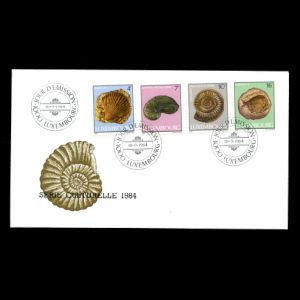 |
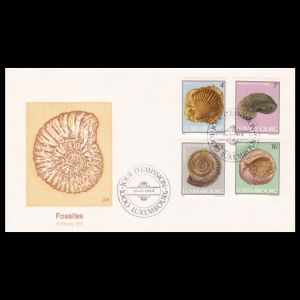 |
 |
| The reverse side is here. | ||
| Example of circulated covers | ||
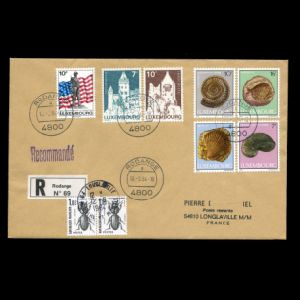 |
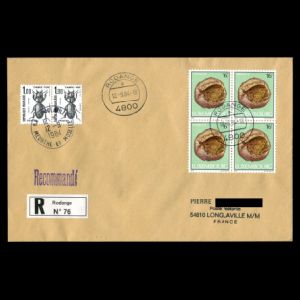 |
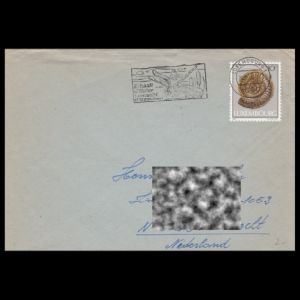 |
|
Both covers have Luxembourgian and French stamps on them.
The French stamps were added at the destination location,
because they were sent to the post office rather than to
the address of the recipient.
The covers include the marking "Poste restante". "Poste restante" (the same term used by many countries in the world), also known as general delivery in North American English, is a service where the post office holds the mail until the recipient calls for it. It is a common destination for mail for people who are visiting a particular location and have no need, or no way, of having mail delivered directly to their place of residence at that time. The French Postmaster added extra postage stamps to charge for this service. |
||
References
 |
- Musée national d'histoire naturelle Luxembourg - natur musée: official website, facebook, Wikipedia, Luxembourg-city.
- Poste restante: Wikipedia,
Acknowledgements
Many thanks to Dr. Peter Voice, PhD Department of Geological and Environmental Sciences, Western Michigan University, USA, for reviewing of a draft of this article.| <prev | back to index | next> |